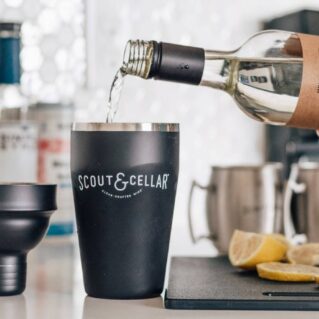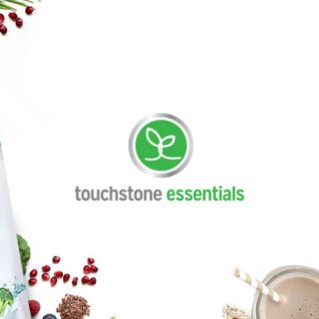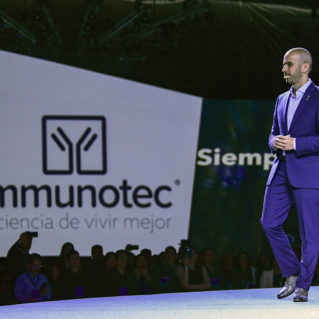Eight years ago three sisters began brainstorming, looking for a way to recreate the cute nail wraps only available at salons. All three cost-conscious moms, Lyndsey Ekstrom, Christy Hepworth and Keri Evans, enjoyed the creative self-expression found in manicure and pedicure colors and styles. But at $60 for hands and another $60 for toes, the women felt certain an alternative could be found.
| Jamberry Founded: 2010 Headquarters: lindon, utah Top Executive: CEO Elizabeth Thibaudeau Products: Nailwraps, Gel Enamel, Beauty and Skin Care |

Elizabeth Thibaudeau

Colette Dahl

Stacy Sova
The sisters couldn’t let go of the idea that a do-it-yourself version could be a reality. After all, the nail wraps were basically stickers. Creative breakthroughs accompanied by serendipity often have the most sticking power, and in this case, Christy’s husband Adam supplied a crucial component.
As the co-founder and CEO of a snow ski manufacturing company, Adam Hepworth had experience adhering vinyl stickers to skis. The sisters researched vinyl until they found a type that lasted a long time and wore well. With the help of a local printer and some stock pattern images, the newfound entrepreneurs launched what would become a multimillion-dollar enterprise, Jamberry Nails.
Customers found the nail wraps through a combination of expos, Groupon and other daily deal sites, and a common theme began to develop. Those excited customers wanted to sell Jamberry products themselves to other customers. The families listened—a trait that is ingrained in the Jamberry culture—and a year after it all began, Jamberry launched in the direct selling channel.
From the beginning, the company’s great challenge has been every company’s dream: overwhelming demand. But the management team, led by Adam Hepworth, continued to grow and tackle the associated problems, such as acquiring the right equipment, outgrowing facilities, eliminating fulfillment and shipping errors, addressing customer issues, and getting the compensation plan exactly right.
Today the company operates across the U.S. and in five additional countries: Australia, New Zealand, the United Kingdom, Canada and Mexico.
“We are confident our positioning to deliver on-trend beauty indulgences that celebrate self-expression will be a winning proposition for consultants and customers.” — Elizabeth Thibaudeau, CEO, Jamberry
Leadership Transitions
By 2014, the sisters were struggling to balance a quality home life with the rapidly expanding business, and took a step back from the day-to-day operations. Though still intimately involved in product development, they wanted to turn their focus back to raising their children. Adam continued to lead the company and executive team.
In 2016, another major leadership change occurred when Adam turned over the CEO role to Elizabeth Thibaudeau. Not a new face, Thibaudeau had previously served the company as vice president for global marketing. Prior to joining Jamberry, she had 20 years of experience with a skincare and nutrition company within the direct selling channel. Adam is continuing with the organization as a board member and major shareholder.

A Focus on New Products and Innovation
There’s a yin and a yang to high product demand as Jamberry’s founders quickly discovered. As the company told Direct Selling News in an early 2016 interview: “We had too many orders.” Not a bad place to be, but high demand did come with some weighty challenges.
To keep up with demand the company explored new manufacturing options, leading to initial bottlenecks and quality issues. The company has worked out those kinks, though, and today is focused on expanding its product line with attention on fast fashion, a term that retailers use to describe clothing designs made quickly and cheaply to capture current trends and meet customer expectations. Jamberry is applying the concept to the beauty industry, using the term “fast beauty.”
CEO Thibaudeau says: “It’s no secret direct sales thrives on fresh and new. In today’s world, consumers are demanding immediate access to products more than ever. Jamberry is perfectly poised to capitalize on these market trends to become the fast beauty leader in direct sales. We are confident our positioning to deliver on-trend beauty indulgences that celebrate self-expression will be a winning proposition for consultants and customers.”
Strengthening that positioning has involved a brand refresh, says Colette Dahl, Jamberry’s chief marketing officer. Dahl has been with the company about a year and says the brand refresh “focused on elevating us to more than just a nail company, to a true beauty company.” The refresh also shifted the company’s image from whimsical to now include sophistication, she says. While Jamberry didn’t change its company name, and stayed close to its legacy by not completely abandoning its legacy look and feel, the brand values and how they’re presented were rethought and included in the company’s manifesto. Colors, packaging and materials were also reimagined and gradually replaced. A new tagline—“Fresh. Daring. Now.”—was then introduced to support the new direction and an expansion beyond nails.
“I feel at Jamberry we were pioneers of social selling and we’ve seen dramatic shifts in purchases and selling patterns in a relatively short period of time.” — Colette Dahl, Chief Marketing Officer, Jamberry
How does the company stay ahead of the curve when it comes to fashion trends? Its strong social media presence, bolstered by the efforts of consultants and brand advocates provides a network of input and innovation that the company has learned to successfully mine. In fact, says Dahl, although company leaders attend many of the top cosmetic and beauty shows, they often find that they have already seen the trends on social media. Jamberry also partners with college and professional sports teams, along with companies like Disney, to create nail wrap collections based on recognizable characters and designs.
While the company initially made its mark with nail wraps, which still remain a core product offering, Jamberry has expanded to encompass other nail and beauty products such as gels and lacquers as well as nail, hand, and foot-care products with hair care on the horizon.

Jamberry consultants are recognized for their achievements at a recent event.
Social Selling: A Unique Virtual Direct Sales Model
Back in 2013, about 80 percent of its business occurred at in-person parties, generally held at consultants’ homes. But by 2015, more than 85 percent of sales were coming through virtual parties—fueled by social media sites, particularly Facebook. Today’s sales also occur primarily online, says Dahl. “The digital environment is just a rapidly changing space, particularly when the majority of your business comes from social media,” she says. “I feel at Jamberry we were pioneers of social selling and we’ve seen dramatic shifts in purchases and selling patterns in a relatively short period of time.”
Today, she notes, it’s not so much parties that lead to its sales, and new customers, but purchases from past customers. “While the initial virality of the product was done through online parties, we’re now seeing a lot of sales coming from repeat business through what our consultants have established as VIP groups.” These are independently run Facebook groups that stylists set up and run on their own to connect with their audiences.
Facebook has historically been the primary channel used by Jamberry to connect with consumers, and Dahl says that hasn’t changed because it’s where consultants spend a lot of their time and where they can establish private groups. But, she adds that in other markets, chat apps like WeChat or WhatsApp are becoming more prevalent. Jamberry also has a strong following on Instagram, due to the visual element of its products, she says. “We’ve seen a lot of emerging younger leaders building their business through Instagram as well.”
New opportunities to connect with audiences using live video also have proven to be both popular and effective, she says, as it allows for more in-depth communication between consultants, their teams and customers, and provides consultants with the opportunity to train and guide their downlines.
“Our ability to attract a variety of demographics, like millennials, has been a large part of our success.” — Stacy Sova, President of Global Sales, Jamberry
VIP groups, says Dahl, are groups that consultants set up online, which allows them to promote to this audience on a regular basis. “That’s probably one of the bigger shifts,” says Dahl. “A lot of our business is coming through repeat, even though parties are still a great way to attract and meet new people.”
Stacy Sova, president of global sales, adds, “Our ability to attract a variety of demographics, like millennials, has been a large part of our success.” A younger demographic also supports the use of social media and online communication channels to build awareness and boost sales, according to the company. In fact, notes Dahl, Jamberry’s social network includes influencers in the beauty and lifestyle space. “Some of our leaders would definitely be considered social media influencers, in general, but particularly influencers in the beauty and life areas—and when it comes to nails,” says Dahl.
Current and past customers also represent opportunities to introduce some of the new product offerings, says Dahl. “Since we’ve expanded our product line we’ll be reaching back out to those who maybe wanted to try the nail space, but it wasn’t their core interest and they had a little more interest on the beauty side. We’ll be making sure we’re effectively mining our existing customers and consultants and bringing them along as we expand our product portfolio.”
A new focus for the organization has been its “preferred customer program” which, says Sova, “has been met with amazing success.” The program, called Style VIP, is designed for those who wish to purchase the product at a discount but don’t, necessarily, want to build a business. For a $15 annual fee, Style VIPs can save 15 percent on every item purchased.
The company also wants to “become the leading subscription box provider of the direct selling space,” she says, capitalizing on the successes of models like Birchbox or Stitch Fix, which have become very popular with consumers.
Despite a focus on some unique social selling opportunities, Dahl says she sees the need to refocus on bringing new people into the business by using other social strategies to increase brand awareness.

Jamberry’s headquarters lobby in Lindon, Utah.
Keeping Communication Lines Open
Communication, particularly social media communication, is a mainstay for Jamberry to stay in touch with its customers; it’s also a big part of its communications with consultants and Style VIPs.
National sales managers facilitate coaching calls with the field and also manage specific Facebook groups for added support and encouragement, Sova says. Consultants also can find support at regional and national events as well as Jamberry University, an online training program that offers short courses, often limited to 5-7 minutes of information in slide or video format.
“As an executive body we are really close to our field. …I think it helps them feel a sense of loyalty and also that they’re being heard, that we care about their input.” — Colette Dahl, Chief Marketing Officer, Jamberry
“As an executive body we are really close to our field,” says Dahl. She notes that she, Sova and CEO Thibaudeau “speak and communicate every day with our field.” That serves, she says, not only to keep them up-to-date and connected, but also yields important insights through their suggestions. And, she adds: “I think it helps them feel a sense of loyalty and also that they’re being heard, that we care about their input.”
Customers also can get into the mix, spurring innovation through their own creativity. Jamberry’s Nail Art Studio encourages users to create and share their own designs, a form of crowdsourcing that is both engaging for consumers and educational for Jamberry.
Moving forward, says Dahl, the company will continue its focus on nails as well as its plan to expand into hair and beauty, leveraging the fast beauty approach to remain cutting edge and relevant. “I feel that helps us be more diverse, increasing the demographics we appeal to.”



